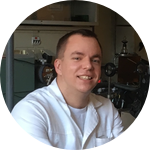About This Project
We use Heart Rate Variability(HRV) algorithms to study how lifestyle affect autonomic nervous system. This method has been used to study the influence of illnesses on the body but has never been used to track trends in people’s health. We've noticed that specific changes occur in HRV measurement before we get sick. If we're able to predict an oncoming cold in advance, we can take measures to avoid getting sick
Ask the Scientists
Join The DiscussionWhat is the context of this research?
The common cold is the most common type of illness. Adults get colds 3-5 times a year. 111 million work hours are lost in the US every year due to the common cold. Science has yet to come up with a way to treat the common cold and all the current medicine are only good for reducing symptoms. Aside from external viruses, everybody has a dormant infection that begins to rear its head as soon as the body’s immune system is weakened due to hypothermia, chronic stress, fatigue and etc. The objective of our research is to identify changes in HRV indicators that would predict the risk of getting a common cold. If we can figure out ways to predict colds, we can figure out how to prevent them! HRV indicators we use to track patterns.
What is the significance of this project?
In the US, people spend over $4.6 million on flu-related medicine annually. We start to infect others one day before we feel any symptoms, which is why the virus spreads so quickly. Preventing colds is all about changing our lifestyle habits. HRV technology is already available to everybody, since people can now take measurements with their cellphone cameras. As apps and devices that track heart rate variability become increasingly more available, every person will be able to reduce the frequency of common colds simply by tracking their measurement results. Everybody can get a quick assessment of their health by taking daily measurements. At Welltory we will be able to evaluate trends and predict the onset of a cold before the appearance of any symptoms.
What are the goals of the project?
The goal of our research is to identify changes in heart rate variability indicators that would predict the risk of getting a common cold and to develop a formula for calculating the risk of getting a cold. The researches which were conducted earlier typically run into problems collecting data and getting a large enough sample size. We already have a database of HRV measurements (over 40,000 users and over 250,000 measurements) that are connected to data about people’s lifestyles. The process of research: We will select people who have had an ARVI, analyze regular HRV measurements and lifestyle factors 1-2 weeks before the person got sick. We'll detect common patterns for research subjects and come up with a formula that predicts the likelihood of getting sick
Budget
The research is funded by us, but we currently need extra $3,000 to attract people, who will help us do research:
1. interviewing 300 people who have the mark - sick and they made measurement 10 days prior the sick: 6$ per 1 interview = $1800
2. experts to process data: data scientist, health analyst: $500
3. programmer and mathematician to put the formula together and identify correlations: $700
You can try how the application works and measure your HRV indicators. The application is available for Android and iOS users for free.
All contributers will get a special promotional code which grant our Quantified Self tariff for free for 3 months. This extendend version of Welltory app allows you not only to measure heart rate variability and learn the levels of stress and energy, but add 200+ additional sources from other gadgets and apps in order to analyze your habits and correlations between health and lifestyle.
Thanks for your support!
Endorsed by
 Project Timeline
Project Timeline
Apr 30, 2017
Project Launched
Jul 01, 2017
Select 300 users that meet the criteria: https://www.dropbox.com/s/e913...
Jul 16, 2017
Interview each user, then separate them into subgroups by age and level of physical fitness, since these factors significantly influence default HRV
Sep 01, 2017
Within each group analyze how HRV indicators changed during the onset and throughout the illness, comparing these indicators to lifestyle data
Sep 17, 2017
Looking for correlations and dependencies between indices of sick people
Meet the Team
Team Bio
Roman M. Baevsky, M.D., is a professor, Honored Scholar, member of the International Academy of Astronautics, member of the International Informatization Academy and Chief Research Fellow at the Institute For Biomedical Problems of the Russian Academy of Sciences. He is one of the founders of astronaut сardiology, and works on applying discoveries made in space medicine to healthcare. He is a research supervisor for 30 PhD dissertations and a research consultant for 5 doctoral dissertations
Evgeniya Smorodnikova
I have a Masters Degree in Tech and Business and received a gold medal from the Ministry of Education for research. I am the cofounder of Welltory, a company that researchers how people’s lifestyles affect their stress and energy levels. I am also the founder of the Academy of Personal Health Analysts and an expert in data science and data security. My fields of interest include Quantified Self, studying the brain, habits and addictions. I am interested in studying people’s lifestyles, gadgets, technologies and programming. I love my job, my dog, friends and family. I am an incorrigible workaholic and test all new techniques for increasing productivity on myself.
Alex Kostyukov
graduated from the Chemical Department of Lomonosov Moscow State University with a master's degree in medicinal chemistry and drug design. From 2010 to 2015, I synthesized fluorescent-marked nucleotides for PCR for biological microchips in biological microchips at EIMB RAS, Moscow. Now, I'm research scientist in IBCP RAS, Moscow. The scope of my interests in time correlated physical chemistry include studying processes of fluorescence and absorption via single photon counting, flashphotolisys and stopped flow. Pass preclinical trials of novel drugs.
I am interested in organic synthesis, novel catalysts for organo-palladium synthesis, chemical kinetics of excited states and practical application of chemical compounds and creation novel drugs.
Also, I like different kinds of sport activities and I understand impact of it on productivit. I really appreciate the ability to consult and improve WELLTORY consumer service using my knowledge in biochemistry and molecular biology.
Lab Notes
Nothing posted yet.
Additional Information
The common cold and flu are the most common types of illness. Aside from symptoms like coughing, sore throat and a stuffy nose, they impact our heart. In a healthy person, heart rate is variable - the time period between each heartbeat (the RR-interval) is not the same, since our heart is sensitive to everything that happens to our body. Any kind of stress makes our heart rate less variable. This happens thanks to two divisions of the autonomic nervous system: sympathetic and parasympathetic. Analyzing HRV gives us reliable data about what’s happening with the autonomic nervous system. Our goal is to track down the moment when a person’s body becomes too stressed and warn them that they might get sick. We will establish how the cold or flu influences a person’s heart through HRV analysis and create a formula.
There have been multiple studies that look into how different viral infections affect HRV all over the world: in Russia http://cyberleninka.ru/article/n/vegetativnye-rasstroystva-u-bolnyh-s-grippom-a-h1n1 and France http://www.autonomicneuroscience.com/article/S1566-0702(10)00059-7/abstract https://www.ncbi.nlm.nih.gov/pubmed/21482200, for example. There is even a study that looks into how flu shots affect HRV https://www.ncbi.nlm.nih.gov/pubmed/23031064. But all of these studies have a series of limitations - a small sample size or a study that was limited to a certain group of people (newborns, for example). We want to look at a large number of people in the 25-45 age group who do not have serious health problems and look into what’s happening with their HRV during an illness, adjusting the study to control for different lifestyle habits.
The flu and the cold are viral infectious diseases that affect the respiratory system, but the flu is placed in a separate category because the triggers and severity of symptoms are usually different. Our goal is to study the influence of these viral infections on HRV and figure out whether or not there is a common pattern. https://www.cdc.gov/flu/about/qa/coldflu.htm
Project Backers
- 2Backers
- 2%Funded
- $60Total Donations
- $30.00Average Donation


